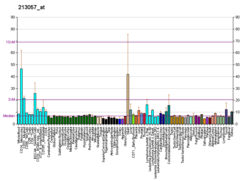ATPAF2 Last updated September 21, 2025 Structure The ATPAF2 gene is located on the p arm of chromosome 17 in position 11.2 and spans 24,110 base pairs. [ 7] The gene produces a 32.8 kDa protein composed of 289 amino acids . [ 10] [ 11] This gene has at least 8 exons and is located within the Smith-Magenis syndrome region on chromosome 17. [ 7]
Function The ATPAF2 gene encodes an essential housekeeping protein , an assembly factor for the F1 component of mitochondrial ATP synthase. This protein binds specifically to the F1 alpha subunit and is thought to prevent this subunit from forming nonproductive homooligomers during enzyme assembly. [ 5] [ 7]
References 1 2 3 GRCh38: Ensembl release 89: ENSG00000171953 – Ensembl , May 2017 1 2 3 GRCm38: Ensembl release 89: ENSMUSG00000042709 – Ensembl , May 2017 ↑ "Human PubMed Reference:" . National Center for Biotechnology Information, U.S. National Library of Medicine . ↑ "Mouse PubMed Reference:" . National Center for Biotechnology Information, U.S. National Library of Medicine . 1 2 3 Wang ZG, White PS, Ackerman SH (August 2001). "Atp11p and Atp12p are assembly factors for the F(1)-ATPase in human mitochondria" . The Journal of Biological Chemistry . 276 (33): 30773– 30778. doi : 10.1074/jbc.M104133200 . PMID 11410595 . ↑ Bi W, Yan J, Stankiewicz P, Park SS, Walz K, Boerkoel CF, Potocki L, Shaffer LG, Devriendt K, Nowaczyk MJ, Inoue K, Lupski JR (May 2002). "Genes in a refined Smith-Magenis syndrome critical deletion interval on chromosome 17p11.2 and the syntenic region of the mouse" . Genome Research . 12 (5): 713– 728. doi :10.1101/gr.73702 . PMC 186594 . PMID 11997338 . 1 2 3 4 5 "Entrez Gene: ATPAF2 ATP synthase mitochondrial F1 complex assembly factor 2" . This article incorporates text from this source, which is in the public domain . 1 2 De Meirleir L, Seneca S, Lissens W, De Clercq I, Eyskens F, Gerlo E, Smet J, Van Coster R (February 2004). "Respiratory chain complex V deficiency due to a mutation in the assembly gene ATP12" . Journal of Medical Genetics . 41 (2): 120– 124. doi :10.1136/jmg.2003.012047 . PMC 1735674 . PMID 14757859 . 1 2 Online Mendelian Inheritance in Man, OMIM. Johns Hopkins University, Baltimore, MD. MIM Number: {608918}: {2017-08-17}: . World Wide Web URL: https://omim.org/ ↑ Zong NC, Li H, Li H, Lam MP, Jimenez RC, Kim CS, et al. (October 2013). "Integration of cardiac proteome biology and medicine by a specialized knowledgebase" . Circulation Research . 113 (9): 1043– 1053. doi :10.1161/CIRCRESAHA.113.301151 . PMC 4076475 . PMID 23965338 . ↑ "ATPAF2 - ATP synthase mitochondrial F1 complex assembly factor 2" . Cardiac Organellar Protein Atlas Knowledgebase (COPaKB) . [ permanent dead link ] ↑ Li Y, Jourdain AA, Calvo SE, Liu JS, Mootha VK (July 2017). "CLIC, a tool for expanding biological pathways based on co-expression across thousands of datasets" . PLOS Computational Biology . 13 (7) e1005653. Bibcode :2017PLSCB..13E5653L . doi : 10.1371/journal.pcbi.1005653 . PMC 5546725 . PMID 28719601 . ↑ "UniProt: the universal protein knowledgebase" . Nucleic Acids Research . 45 (D1): D158 – D169 . January 2017. doi :10.1093/nar/gkw1099 . PMC 5210571 . PMID 27899622 . Further reading Andersson B, Wentland MA, Ricafrente JY, Liu W, Gibbs RA (April 1996). "A "double adaptor" method for improved shotgun library construction". Analytical Biochemistry . 236 (1): 107– 113. doi :10.1006/abio.1996.0138 . PMID 8619474 . Yu W, Andersson B, Worley KC, Muzny DM, Ding Y, Liu W, Ricafrente JY, Wentland MA, Lennon G, Gibbs RA (April 1997). "Large-scale concatenation cDNA sequencing" . Genome Research . 7 (4): 353– 358. doi :10.1101/gr.7.4.353 . PMC 139146 . PMID 9110174 . Hartley JL, Temple GF, Brasch MA (November 2000). "DNA cloning using in vitro site-specific recombination" . Genome Research . 10 (11): 1788– 1795. doi :10.1101/gr.143000 . PMC 310948 . PMID 11076863 . De Meirleir L, Seneca S, Lissens W, De Clercq I, Eyskens F, Gerlo E, Smet J, Van Coster R (February 2004). "Respiratory chain complex V deficiency due to a mutation in the assembly gene ATP12" . Journal of Medical Genetics . 41 (2): 120– 124. doi :10.1136/jmg.2003.012047 . PMC 1735674 . PMID 14757859 . Wiemann S, Arlt D, Huber W, Wellenreuther R, Schleeger S, Mehrle A, Bechtel S, Sauermann M, Korf U, Pepperkok R, Sültmann H, Poustka A (October 2004). "From ORFeome to biology: a functional genomics pipeline" . Genome Research . 14 (10B): 2136– 2144. doi :10.1101/gr.2576704 . PMC 528930 . PMID 15489336 . Mehrle A, Rosenfelder H, Schupp I, del Val C, Arlt D, Hahne F, Bechtel S, Simpson J, Hofmann O, Hide W, Glatting KH, Huber W, Pepperkok R, Poustka A, Wiemann S (January 2006). "The LIFEdb database in 2006" . Nucleic Acids Research . 34 (Database issue): D415–8. doi :10.1093/nar/gkj139 . PMC 1347501 . PMID 16381901 . This page is based on this
Wikipedia article Text is available under the
CC BY-SA 4.0 license; additional terms may apply.
Images, videos and audio are available under their respective licenses.




